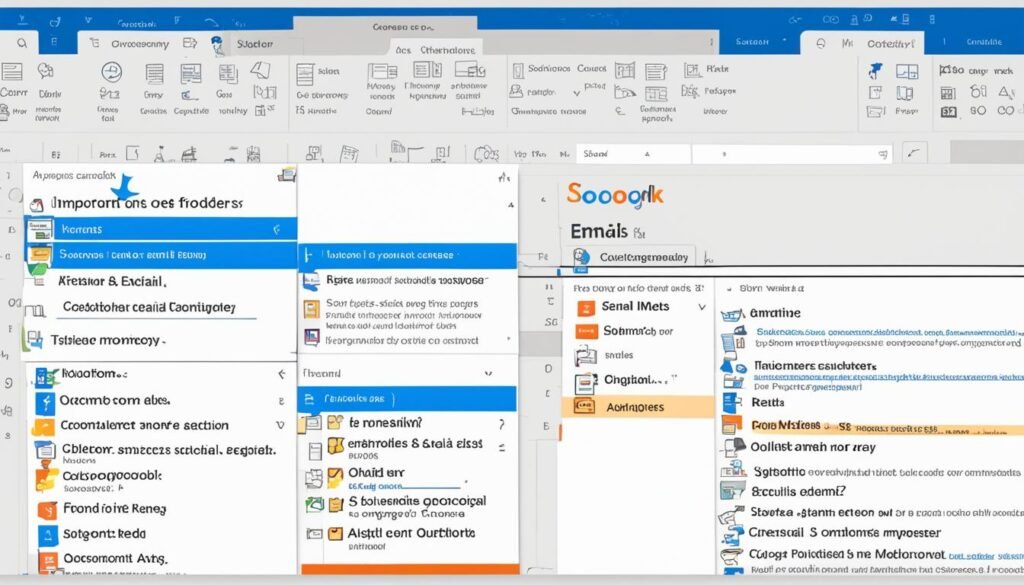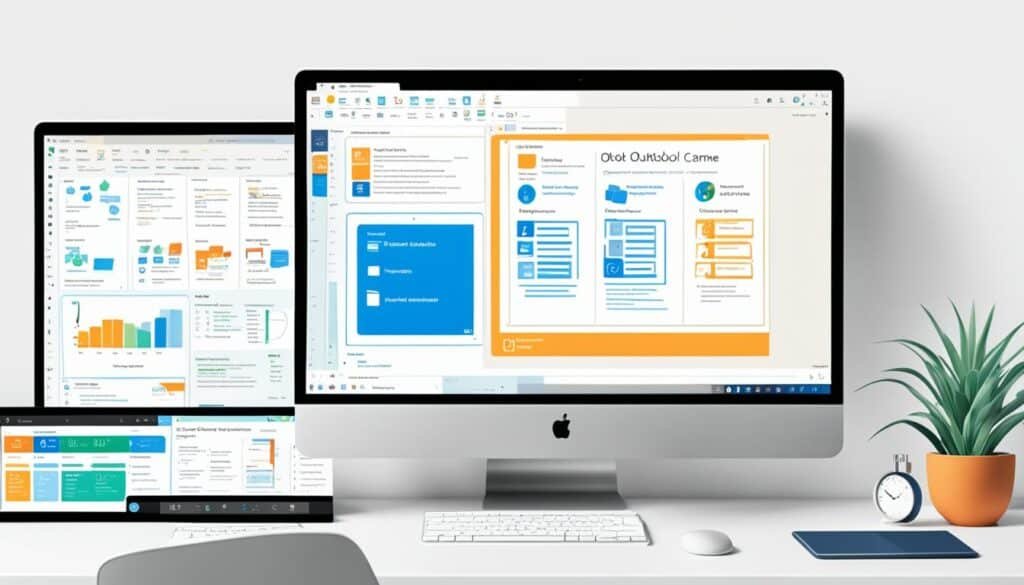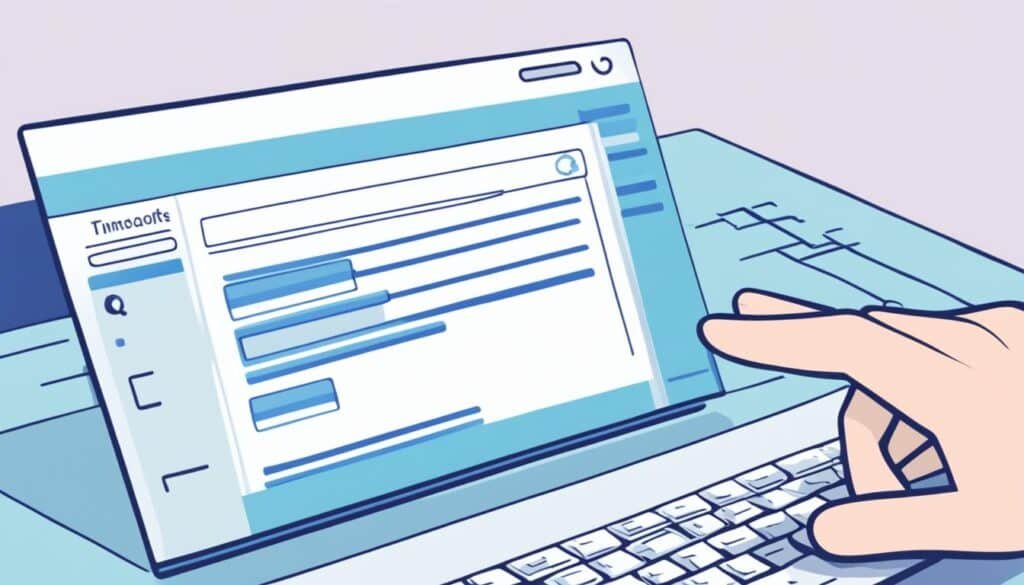Over 500 million people use Microsoft Outlook to stay organized. Mastering its features is key to email efficiency and better work productivity1. Imagine saving up to 2.5 hours a day. Hours you could use to reach your goals, instead of sorting emails or planning tasks1. By organizing your inbox and using time management tips in Outlook, you can enhance your skills. This transforms how you work, one click at a time.
Outlook isn’t just for emails; it’s a powerful tool for managing your calendar, contacts, and tasks. By checking fewer places for messages, categorizing emails, and using the To-Do Bar, you can hugely improve everyday efficiency2. Quick Steps can save an hour each week by automating repeat tasks1. Also, only getting notifications for important emails helps keep your focus sharp on what really matters1.
Your Outlook experience can be smooth and productive. Use this productivity powerhouse well, and see your time management skills soar. This will become a key part of a successful workplace culture.
Key Takeaways
- Master the art of time management within Microsoft Outlook to optimize your day.
- Streamline communications by centralizing where you read and manage emails.
- Leverage Outlook’s rules and To-Do Bar to organize your inbox effectively and view essential activities.
- Automate repetitive tasks with Quick Steps to save time and enhance productivity.
- Maintain focus on your work by minimizing email notifications and distractions.
Maximizing Your Outlook Layout for Peak Performance
To truly optimize Outlook for productivity, you need to adjust your Outlook setup. A great layout makes things easier to see and saves time when you use the app.
Optimizing the Navigation Pane and Reading Pane
Having the Navigation Pane open and the Reading Pane on the right helps organize your inbox effectively. It lets you quickly see folders and preview emails without opening them. Customizing these areas can make managing email easier and reduce distractions. Find tips to boost your email skills at optimize outlook for productivity3.
Utilizing Conversations View and Quick Click Flags
The Conversations view keeps related emails together. This makes it simpler to follow ongoing conversations and keeps your inbox neat. With Quick Click Flags, you can mark emails for later action in a snap, which helps with organizing your tasks better.
Streamlining with Cached Exchange Mode
Using Cached Exchange Mode boosts Outlook’s performance. It lets you access emails offline and keeps your inbox updated, even with a weak network. Learn more about improving network performance at performance recommendations for Microsoft 3654.
Remember, using outlook shortcuts for efficiency is crucial when setting this up. Shortcuts greatly enhance your email handling and Outlook navigation speed.
By wisely using these settings, you’re on your way to a more productive Outlook experience.
Efficient Email Management with Outlook Folders
Getting to know productivity hacks using Outlook means learning to organize your inbox effectively. If you want to manage your emails better, using folders is key. This method makes sorting emails easy and lets you find things fast.
To keep your inbox neat, make different folders for projects, clients, or issues. With Outlook’s Rules, you can sort emails automatically based on who sent them or the subject5. Use Color Categories and flags for quick email sorting by priority and action needed5.
Make managing emails easier by creating to-do lists and reminders in your inbox. By flagging key messages, you save time spent on emails each day6.
| Folder Type | Purpose | Features |
|---|---|---|
| Projects | Sort emails related to specific ongoing projects | Use Quick Steps for repetitive tasks5 |
| Clients | Keep client communications accessible | Automate with Outlook Rules7 |
| Personal | Separate personal emails from work-related | Manual categorization with labels7 |
The Focused Inbox feature can change how you deal with emails. It sorts important emails so you can focus on them first. This way, you won’t miss anything important5.
For more tips on using email folders, look at online guides like organizing emails in Outlook. These tips work for all versions of Outlook. They help you keep on top of your work and meet deadlines6.
Also, customize your inbox to fit your style. Changing the layout and how you view emails can make a big difference. This makes managing your inbox easier every day5.
Improving your email habits with Microsoft Outlook helps you work smarter. Try these ideas to make your inbox more helpful. Turn your inbox into a tool that supports your goals.
Customizing Rules to Streamline Your Inbox
In today’s fast-paced work environment, knowing Outlook tips and tricks for productivity is key. By setting up clear rules in Outlook, you can increase work productivity8. This helps organize your day better.
Setting Up Rules for Email Sorting
Begin by sorting your emails to focus on the urgent ones first. The Quick Steps feature is a top tip for managing your emails better. It saves you minutes every day9. Also, making rules to move emails from certain senders to specific folders can keep your inbox tidy8. For instance, a rule to highlight emails from important contacts helps you respond quickly. This ensures clear communication and timely replies8.

Creating Auto-Archive Parameters for Optimal Organization
Setting auto-archive rules helps manage your space and keep important emails for longer. These rules move old emails to an archive folder, keeping your inbox neat8. You can also make a rule to delete or compress email attachments. This improves your mailbox’s performance and avoids storage problems8. This method, advised by experts, keeps your inbox organized by periodically cleaning it8.
Using these outlook tips and tricks for productivity tidies up your inbox. It also helps manage your time and tasks more effectively. For more insights and deep strategies, check out this comprehensive guide on managing your emails10.
Clearly, setting up different rules in Outlook greatly improves how you work. It helps categorize emails and manage your messages better. These steps make sure you are more efficient every day.
Enhancing Productivity with the To-Do Bar
The To-Do Bar in Microsoft Outlook is a key tool for boosting your productivity and managing your work. It uses the Date Navigator, Task List, and Favorite Folders to integrate and offer reminders. These features help organize your day, making it more manageable and less stressful.
Leveraging the Date Navigator and Task List
Begin your day by linking your tasks and calendar events with the To-Do Bar. This makes your inbox organization smoother. The Date Navigator lets you quickly see your monthly calendar. Below, the Task List shows your day’s or week’s tasks11.
Interacting directly with your schedule saves time11. Checking your tasks early creates a plan for managing your time. This organized approach improves your workflow in Outlook12.
Favorites: Quick Access to Your Priority Folders
Choosing folders for Favorites saves you time finding often-used folders. It’s great for people with many email accounts. Placing these in Favorites lets you quickly get to important emails13.
Using Favorites with the To-Do Bar simplifies managing your time13. It helps keep your focus on important tasks during your day.
With Outlook’s features and good time management, you can enhance how you work each day. The To-Do Bar, along with Email, Calendar, and the Sweep function11, helps you organize and prioritize tasks. This ensures you’re working at your best.
Smart Use of Categories and Quick Steps
Getting more done with Outlook can make your day smoother14.Categories let you color-code emails, contacts, and appointments. This makes finding items easy and ensures you don’t miss out on anything important. Many use Outlook’s shortcuts, like automatic replies, to keep in touch even when they’re away.
Quick Steps in Outlook also make life easier14.With just one click, you can move emails to folders, send group messages, or set appointments. This reduces the need for repetitive steps and ups your efficiency. Many have turned to Quick Steps to make email management a breeze.

- Categories enable a visual organization layer on top of your communication pile, aiding in swifter identification and retrieval.
- Quick Steps automate frequent email actions, reducing the number of clicks and time spent on email management.
Imagine Quick Steps sending messages to your team automatically14.It pre-fills recipient details and subject lines, even adding CC or BCC. This is great for handling regular group emails, ensuring quick sharing and faster replies.
| Feature | Function | Usage Percentage |
|---|---|---|
| Email Encryption | Secures content | 60%14 |
| Automatic Replies | Maintains communication without active management | 75%14 |
| Quick Steps Usage | Simplifies repetitive tasks | 70%14 |
Outlook’s Categories and Quick Steps are not just extras14.They’re key for managing your digital workflow well. Using them daily saves time and improves how you handle emails. This lets you focus more on what’s important.
Managing Distractions: Tuning Your Notifications
To improve email use and productivity with Outlook, it’s key to handle notification settings right. By choosing wisely when and how to get alerts, you cut down distractions at work. This helps make your daily tasks smoother.
Custom Notifications for a Focused Workday
Think about getting things done without every email breaking your concentration. By picking the right notifications, you can keep on track with important work. Getting less bothered helps you dig into tasks better with Microsoft Teams’ “Do Not Disturb” mode15.
Getting alerts only for important emails means less inbox clutter. This not only boosts your work rate but also lowers stress. Such steps make your work-life balance better.
Did you know people need around 23 minutes to refocus after a distraction15? Setting up your notifications smartly saves a lot of brainpower. Getting fewer but more crucial alerts helps you stay on top of your emails each day16.
It’s smart to look into how to handle notifications beyond just email settings. Checking out guides on workplace distractions can give you more tactics. These resources help sharpen your notification setup to boost work productivity.
Using MyAnalytics in Outlook is good for watching your focus levels15. It lets you personalize your alerts to match your most productive times. This way, you’re only disturbed when necessary.
Checking your notification settings regularly is vital as your job changes. Updating your settings helps you keep pacing well with work demands. Learning these tricks gives you an edge in handling your professional tasks.

To get better at managing your emails, exploring resources like email productivity hacks for better time use and AI updates minimizing distractions is wise. They offer key advice and methods to lift your productivity using Microsoft Outlook.
Improve Email Efficiency with Keyboard Shortcuts
Learning Outlook shortcuts for efficiency can boost your productivity. Adding outlook tips and tricks for productivity into your daily tasks cuts down email management time. This makes routine tasks quicker to complete.
Key Shortcuts to Navigate and Execute Actions
Outlook shortcuts for efficiency make managing emails quicker. Knowing 41 Microsoft Outlook keyboard shortcuts saves up to 30 minutes daily17. Shortcuts like Ctrl+N for a new email or Ctrl+Enter to send one save precious seconds. These seconds add up, giving you more time throughout the day18. Keys like ‘Ctrl + Shift + M’ for a new meeting or ‘Alt + S’ to save emails improve communication management18.
Shortcuts also make moving around Outlook faster. You don’t need the mouse. ‘Go to Mail’ and ‘Go to Calendar’ get you there in no time, making work flow smoother17.
Customizing Hotkeys for Personal Workflow
Outlook lets you customize keyboard shortcuts. This means you can set them up as you like. Choosing quick steps for actions you do a lot, like moving emails or marking them as read, turns many steps into one. This greatly boosts your productivity1819.
Here’s a list of key Outlook shortcuts to enhance your efficiency:
| Function | Shortcut | Description |
|---|---|---|
| Create Email | Ctrl + N | Quickly open a new email window. |
| Send Email | Ctrl + Enter | Send your email swiftly. |
| New Meeting | Ctrl + Shift + M | Open a new meeting request form. |
| Save Email | Alt + S | Save the current email or send it. |
| Go to Mail | Ctrl + 1 | Switch to Mail view in Outlook. |
| Go to Calendar | Ctrl + 2 | Switch to Calendar view in Outlook. |

Using outlook tips and tricks for productivity like keyboard shortcuts improves efficiency. Start using these shortcuts to manage your emails better. You’ll see your workflow improve right away.
Master Time Management Tips Within Outlook
Managing your time well is key to doing well at work. Microsoft Outlook is a powerful tool for this. It helps you use time wisely and gives tips for doing better at work.
Balancing Your Calendar for Better Day Planning
Outlook’s calendar can make planning your day easier. Adding colors to events makes it easy to see what you have to do20. This method saves time by keeping tasks organized20. Setting time for each project helps you stay focused and boosts your work rate20.
Sharing your calendar with team members helps with scheduling meetings20. Everyone knows what’s happening and can prepare well.

Integrating Tasks and Calendar for a Unified View
Combining tasks and calendar in Outlook gives a clear view of your duties. This makes it easier to decide which task is most urgent. It’s great for planning your day well. The “Scheduling Assistant” finds good meeting times for everyone20. And, dragging tasks to your calendar is simple21.
Linking your calendar with CRM software keeps you on track with customer meetings21. This makes your workday smoother and more productive.
Using Outlook’s tools not only boosts your work output. It also helps you organize your time, making your day less chaotic.
Conclusion
Optimizing Outlook with these productivity hacks can change your workday for the better. Using keyboard shortcuts, like Ctrl + Shift + S for saving and Ctrl + Shift + C for copying, speeds up your email and task management22. With over 500 million users worldwide relying on Outlook for emails and scheduling, knowing how to use it well is key for success in today’s fast-moving business world2324.
Outlook has advanced tools like the Focused Inbox and Quick Steps that make your day smoother23. Setting up email signatures saves you hours spent typing the same things over and over22. And planning when to send emails with the delayed delivery feature means your messages arrive at the perfect time, increasing your chances of getting quick replies22.
Becoming a pro with Outlook isn’t just about your success; it helps your whole team work better. With the power of Outlook’s sorting and search tools, you can drastically cut down on the time spent on emails, which takes up about 28% of our workdays24. Embrace these Outlook hacks to make your work life efficient and more organized.
FAQ
How can I improve my email efficiency in Outlook?
To boost your email efficiency in Outlook, start by improving your layout. Have the Navigation Pane open and place the Reading Pane on the right. Group related messages using Conversations view.
Utilize Quick Steps for tasks you do often. Set rules to filter emails and manage your notifications. Learn shortcuts to work faster.
What are some key time management tips for using Outlook?
For better time management in Outlook, use the calendar to plan your day. Add tasks to the calendar for an overview of your duties. Use the To-Do Bar to track tasks and appointments.
Organize your inbox well to save time when dealing with emails.
How should I organize my inbox for maximum productivity?
Create a simple folder system for your inbox. Have a folder for reference, personal items, and career-related emails. Make spaces for Contact Groups and RSS Feeds too.
Use search folders for quick finds. Set rules to keep less important emails out of your main view. This lets you focus on important stuff.
Can you provide some tips on customizing Outlook for peak performance?
For top performance in Outlook, use Cached Exchange Mode for speed and offline access. Organize your Navigation and Reading Panes to suit you. Stick with Conversation view for emails.
Use blue for messages sent directly to you. Also, use Quick Click Flags to remember to follow up.
What are some effective ways to streamline my inbox with Outlook rules?
Streamline your inbox by automated sorting with Outlook rules. Move meeting responses with no content to Deleted Items. Prioritize critical emails. Filter messages from groups.
Set auto-archive to keep things tidy without manual sorting.
How do I use the To-Do Bar for enhanced productivity?
The To-Do Bar helps you by showing your calendar, upcoming tasks, and flagged emails. Arrange tasks by due or start date. Add a Favorites section for quick access to what matters most.
How can I effectively use Categories and Quick Steps in Outlook?
Use Categories to organize emails, calendar items, and contacts by color. This groups tasks making them easier to manage. Quick Steps simplifies complex tasks. You can send emails to specific people or organize them with less effort.
What is the best way to manage distractions from Outlook notifications?
Customize your notifications to only alert you for very important emails. Choose alerts from specific people or subjects. This keeps you focused on the task at hand without constant interruption.
What are some useful Outlook keyboard shortcuts for efficiency?
Improve your efficiency with shortcuts. Use Ctrl+N to create messages, Ctrl+R to reply, and Ctrl+F to forward. Ctrl+Shift+I takes you to your inbox. Customize more shortcuts to fit your needs.
How can I balance my calendar and task management in Outlook for better productivity?
Balance your calendar and tasks by integrating tasks into your calendar. This shows your daily responsibilities and tasks side by side. It helps in scheduling and ensures you have time for tasks and meetings.
